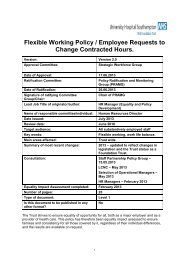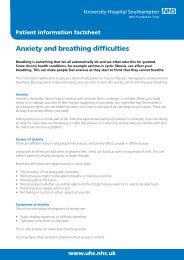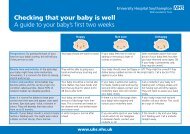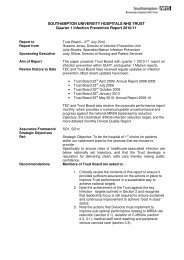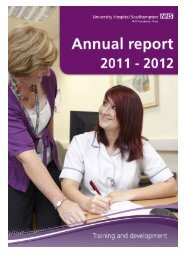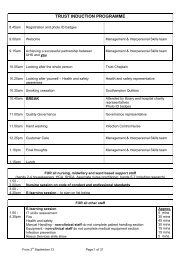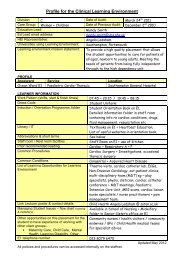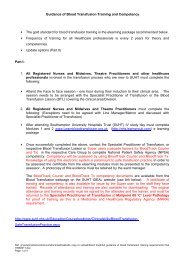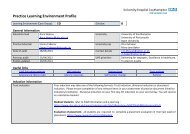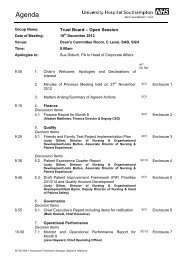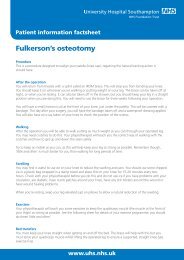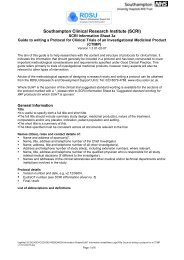ninety years of service - University Hospital Southampton NHS ...
ninety years of service - University Hospital Southampton NHS ...
ninety years of service - University Hospital Southampton NHS ...
- No tags were found...
Create successful ePaper yourself
Turn your PDF publications into a flip-book with our unique Google optimized e-Paper software.
A new department. including X-ray was provided in 1928 on the Ground floor <strong>of</strong> the new Shirley Wing built on to the front<strong>of</strong> the old house. Dr Vincent Rice was appointed to the staff in the following year being in charge <strong>of</strong> massage, electrotherapyand x-ray. The department was run by Mrs Thomas from 1931 to 1947. In that year Dr Ormiston wanted space forhis new gastro-enteritis ward so the physiotherapy section <strong>of</strong> the department was moved across the side drive to the oldkitchens at the back <strong>of</strong> Oakfield. Dr Jim Preston was appointed Director <strong>of</strong> Physical Medicine in 1948 and attended theChildren’s <strong>Hospital</strong> on alternate Thursday afternoons until we moved in 1974. The department consisted <strong>of</strong> three rooms, awaiting room, a treatment room and a storeroom. As well as a desk and couch the treatment room had wall and parallelbars and also ultra-violet and infrared lamps. At first the main referrals were children with asthma and some with minororthopaedic disorders but later those with cerebral palsy and spina-bifida dominated the scene. Many <strong>of</strong> these requiredprolonged physiotherapy and perhaps the provision <strong>of</strong> appliances following orthopaedic operationsX-ray Department“As mentioned above, X-ray equipment was first provided in 1928. After thewar this had become obsolete and an appeal for funds to buy a newmachine was launched. With the transfer <strong>of</strong> Physiotherapy across the drivethe X-ray department became independent and Dr Rice confined hisresponsibilities to radiology. Consultant cover was rather thin for some<strong>years</strong> and I had to do my own screening <strong>of</strong> heart cases. I also did my ownbronchograms using a technique I had learned at Great Ormond Street,which involved the introduction <strong>of</strong> a barbarous cannula through the cricothyroidmembrane. I soon abandoned this method.Dr Ivan Hyde came to the Children’s <strong>Hospital</strong> in 1965 to replace Dr BobCaton, Dr Rice having retired earlier. Anne Arscott was the radiographer incharge assisted by a part-timer doing three sessions. The previoussecretarial cover had been lost. Dr Hyde remembers “The main entrance tothe hospital was by a side door into a small hall around which were clustered the telephone exchange, Matron’s <strong>of</strong>fice, themilk kitchen, the main passage and the entrance to the X-ray department. Immediately inside this door was a sizeableroom containing the x-ray set which was suitable for straightforward radiology and fluoroscopy (with dark adaptation).Opening <strong>of</strong>f this room by a narrow passage were in sequence, the darkroom, a small <strong>of</strong>fice and a lavatory, in which theyalso made the c<strong>of</strong>fee. All film processing was manual, In 1967 Anne Arscott left and was replaced by Sandra Read.During this year David Williamson asked me it I thought an image intensifier would be a suitable objective for the<strong>Southampton</strong> Carnival Appeal, an opportunity not to be missed, The appeal was supported by Dr Horace King, Speaker<strong>of</strong> the House <strong>of</strong> Commons and the machine was handed over by Dr and Mrs King in July 1970. Drs Brunton and Burrowsalso attended the hospital but were replaced by Dr Cook in 1968”.“1969 was a milestone when I was allowed a part-time secretary. She was Sheila Clement, who came as a temp. from thesecretarial agency and stayed with us until her retirement. In May this year JDA arrived and the pace <strong>of</strong> changeincreased”.“The second part-time Radiographer post was filled by a number <strong>of</strong> excellent young ladies - Jenny Bullivant, Hilary Smith,Stella Bowyer. Most <strong>of</strong> our radiographers left to have babies and many <strong>of</strong> them came back to us afterwards in a part-timecapacity and some are still with us. In 1971 we acquired a second part-time secretary, Rosemary Port, also from theagency and she is still with us, soon to retire (1990).“From about 1968 Registrars in training in Radiology came to the Children’s as part <strong>of</strong> their course and they are all nowconsultants.“The thing that stands out most in my recollections is the quality <strong>of</strong> the Radiographers. Their work was <strong>of</strong> a high standardunder very difficult conditions. No one grumbled about working too hard or too long and being such a small hospital therewas a very good rapport with the nursing staff, admin, domestics, porters - everyone employed on the site. The sameapplied to Sheila Clement and Rosemary Port when they were appointed secretaries One never had any demarcationdisputes or rivalries.“John Atwell and Neil Freeman provided us with a substantially increased workload <strong>of</strong> greater complexity. They drew inan enormous amount <strong>of</strong> surgical material, which required more radiological investigations, and all <strong>of</strong> us felt it was apleasure to work with such experts. Working in such a well-defined children’s unit gave us the nucleus to transfer bodily tothe General <strong>Hospital</strong> where we could so easily have been fragmented and separated from the body <strong>of</strong> Paediatrics.Looking back the accommodation and facilities were poor but no worse than those at the General and Royal South Hants.“The neonatal ward was next to the X-ray department which was very convenient as sister would pick up the very sickbabies and transport them for immediate radiology and back to the ward in no time at all. We learned how to handle thesesick infants with confidence and we also learned how to accommodate the increasing volume <strong>of</strong> cases with dispatch. Itwas the time when spina-bifida was treated aggressively - we did enormous numbers <strong>of</strong> micturating cystograms, IVPsand air encephalograms. Congenital abnormalities <strong>of</strong> the Gl and GU tracts also required radiological investigations bothbefore and after operation.“Medical paediatrics did not change in such a revolutionary manner - it was a case <strong>of</strong> more <strong>of</strong> the same. Pr<strong>of</strong> Normand



